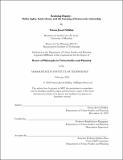Realizing dignity : Dalits rights, land reform, and the learning of democratic citizenship
Author(s)
Siddiqi, Faizan Jawed.
Download1237277941-MIT.pdf (47.45Mb)
Alternative title
Dalits rights, land reform, and the learning of democratic citizenship
Other Contributors
Massachusetts Institute of Technology. Department of Urban Studies and Planning.
Advisor
Balakrishnan Rajagopal.
Terms of use
Metadata
Show full item recordAbstract
This dissertation addresses the questions: When, and how, are durable inequalities disrupted and democratic citizenship deepened in societies that are politically committed to liberal democracy but have substantial social inequalities? How do law and social movements influence and shape this process? I develop answers by examining a successful case of land reform in Surendranagar (Gujarat, India), which was the result of socio-legal mobilization spearheaded by a local human rights organization called Navsarjan Trust. My main argument is that by working with Dalits in Surendranagar Navsarjan caseworkers helped articulate and popularize what philosopher Martha Nussbaum has called the "public myth of equality." I develop this main argument by developing responses to four questions. First, what was the role of emotions and reasons in shaping the organizational strategy and praxis of Navsarjan? I show that the robustness of Navsarjan's strategy came from strategic deployment of emotional energy. Second, is the land redistribution implementation better understood as "top-down" or "bottom-up?" By showing how under unanticipated circumstances, Navsarjan partnered with the local bureaucracy, I argue that the implementation process transcends neat categorization into either category. Third, how do constitutional expressive norms--abstract principles that are supposed to order and restrain the state--matter in the shaping Dalit politics? I show that constitutional expressive norms matter fundamentally but contingently. Fourth, was law merely used instrumentally to mount resistance to upper caste oppression or did it also create a "moral deepening" within the Dalit community? I argue that while for many land reform beneficiaries law was a strategic choice, once they expressed loyalty to it, they publicly bound themselves to its moral commitment. This was used strategically and purposively by Navsarjan caseworkers that pressured community members to live up these moral commitments in their social relations. In conclusion, I argue that the project of "realizing dignity" is likely to continue in Surendranagar because Navsarjan's efforts have not only created a narrative of hope in the Dalit community but also helped its members develop the skills, knowledge, and networks that are needed to put rights to work and achieve positive results.
Description
Thesis: Ph. D., Massachusetts Institute of Technology, Department of Urban Studies and Planning, September, 2020 Cataloged from student-submitted PDF of thesis. Includes bibliographical references (pages 203-214).
Date issued
2020Department
Massachusetts Institute of Technology. Department of Urban Studies and PlanningPublisher
Massachusetts Institute of Technology
Keywords
Urban Studies and Planning.